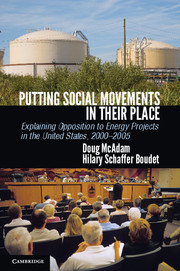 Putting Social Movements in their Place
Putting Social Movements in their Place Book contents
- Frontmatter
- Contents
- Acknowledgments
- 1 From Copernicus to Ptolemy and (Hopefully) Back Again
- 2 Comparing Communities “At Risk” for Mobilization
- 3 Explaining Variation in the Level of Opposition to Energy Projects
- 4 Does Opposition Matter?
- 5 From Not in My Backyard to Not in Anyone’s Backyard
- 6 Back to the Future
- Appendix A Additional Community Data Collected Not Used in Causal and Outcome Condition Scoring
- Appendix B Raw Data and Methods for Scoring Causal Conditions
- Appendix C Interview Sources by Case
- Bibliography
- Index
- References
1 - From Copernicus to Ptolemy and (Hopefully) Back Again
Published online by Cambridge University Press: 05 June 2012
- Frontmatter
- Contents
- Acknowledgments
- 1 From Copernicus to Ptolemy and (Hopefully) Back Again
- 2 Comparing Communities “At Risk” for Mobilization
- 3 Explaining Variation in the Level of Opposition to Energy Projects
- 4 Does Opposition Matter?
- 5 From Not in My Backyard to Not in Anyone’s Backyard
- 6 Back to the Future
- Appendix A Additional Community Data Collected Not Used in Causal and Outcome Condition Scoring
- Appendix B Raw Data and Methods for Scoring Causal Conditions
- Appendix C Interview Sources by Case
- Bibliography
- Index
- References
Summary
From its modest beginnings during the 1970s and early 1980s, the study of social movements has developed into one of the largest subfields in American sociology. In recent years, scholars in a host of other disciplines or fields – including political science (Beissinger 2001; Bunce 1999; Dalton, Van Sickle, and Weldon 2009; della Porta 1995; Dosh 2009; Kitschelt 1995; Koopmans 1993; Kriesi et al. 1995; O’Brien and Li 2006; Tarrow 2005; Wood 2003; Yashar 2005), organizational studies (Davis and McAdam 2000; Davis et al. 2005; Ingram, Yue, and Rao 2010; Lounsbury 2005; Rao, Monin, and Durand 2003; Strang and Soule 1998; Vogus and Davis 2005), education (Binder 2002; Davies and Quirke 2005; Hallett 2010; Rojas 2006, 2007; Slaughter 1997; Stevens 2001), environmental studies (Aldrich 2008; Rootes 2003; Rucht 1999; Sherman 2011; Vasi 2011), and law and society (Edelman, Leachman, and McAdam 2010; Gustafsson and Vinthagen 2011; Kay 2005; McCann 1994; Pedriana 2006) – have turned increasingly to social movement theory in an effort to better understand the dynamics of conflict and change within their respective scholarly domains. But even as we acknowledge and celebrate the vibrancy of the field, we worry about what we see as its increasing narrowness. In his 2009 article in Annual Review of Sociology, Andrew Walder voices similar concerns, criticizing what he sees as the field’s preoccupation with the dynamics of “mobilization” and general disinterest in a host of broader topics, including the traditional focus among political sociologists on the macrolinks between social structure and various forms of political behavior. There are, however, two other sources of “narrowness” in the field that concern us even more than the one identified by Walder.
- Type
- Chapter
- Information
- Putting Social Movements in their PlaceExplaining Opposition to Energy Projects in the United States, 2000–2005, pp. 1 - 27Publisher: Cambridge University PressPrint publication year: 2012


